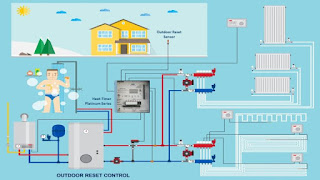What are Weather Activated Heating Controls?
Large heating systems for multi-unit or commercial buildings are designed
to heat the building, and then keep temperatures as close to the set-point as
possible. To do this using the least amount of energy possible maintaining
heating system efficiency is key. Energy efficiency guarantees that the heating
system will use the least amount of energy while keeping the building and all
its tenants comfortable. Since the amount of heat a building loses to the
outside changes considerably as the outdoor conditions change, it makes sense
that the heating system should adjust as well. Weather activated heating
controls adjust how a heating system functions to meet the heating demands of a
building in the most efficient manner possible.
Outdoor Air Reset (Outdoor Reset Controls)
The most widely used weather activated heating control is commonly known
as “Outdoor Reset”. Outdoor reset
is really just a sensor that monitors the outside temperature as a way of
adjusting the boiler set-point down as the outdoor conditions warm. This
dynamic change of the set-point is referred to as “reset”, and since the basis
for the change is the outside conditions, the whole process is referred to as
“outdoor air reset”. By decreasing the boiler set-point, load is taken off the boiler
without compromising the system’s ability to meet the heating demands. Control
valves in the system will open more, allowing higher flow at the lower
temperature, but the fuel savings far outweigh the slight increase in pumping
energy. All told, for every 4℉ the boiler set-point is adjusted up, a 1% gain in efficiency can be
realized.
Reset Parameters
A heated building is always losing heat through the doors, windows and
walls. The colder it is outside, the faster this heat flow occurs. Systems are
typically engineered for worst case, and therefore use boiler set-points of
around 180℉, which would meet the heat load when it is very cold outside. When heat
is still required but the outdoor conditions are more mild, the boiler
set-point can be set as low as 120℉, which would yield an average efficiency gain of around 15%. The trick
is to carefully pick the temperature where this reset starts, and how quickly
the set-point changes.
The start of the outdoor air
reset is usually called “Offset” and varies from 0℉ for older radiator
/ baseboard systems and goes up to 20℉ for forced air heating systems due to the different way these systems
heat the space up. How quickly the set-point should be adjusted is called
“Reset ratio”. It is typically expressed in the number of degrees the outdoor
air needs to change before the system should change by one degree. The reset
ratio is mostly dependent upon the building materials and how well insulated
and sealed the envelope is. For heavy construction such as concrete forms a
reset of 4:1 is common, whereas most lighter construction uses a ratio of 2:1
or 1:1.
An example of a robust method of implementing outdoor air reset is
Heat-Timer’s® Multi-MOD
control system. This package utilizes a multiple input sensors and allows
for quick update of reset ratio and offsets to allow fine control of the reset.
The ease of use inherent in this control is extremely important since
contractors are often not able to test out systems in a large range of outdoor
conditions at point of installation. Heat Timer Controls are designed to be
easy to control, providing internet access and mobile apps that expose all
settings related to outdoor reset and other parameters. This means building
operators can easily be taught to adjust these parameters down the road, from
the comfort of their living rooms.
Heating Professionals Trust Heat-Timer® Valves
Heat-Timer® is dedicated to providing the highest quality heating
control solutions on the market. Our team of technical experts can help you
pick out the right equipment for the job, be it a school, apartment complex,
retail center or hotel. You can rest easy knowing your systems are being
reliably controlled for occupant safety and maximum energy savings.
Contact us today and speak to a technician or visit our website at https://www.heat-timer.com.
Original content posted on https://www.heat-timer.com/what-are-weather-activated-heating-controls/




Comments
Post a Comment